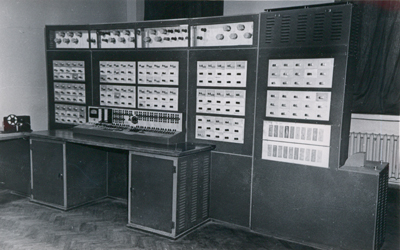
This is a non-standard but still positional numeral system. Its feature is that digits can have one of the values -1, 0 and 1. Nevertheless, its base is still 3 (because there are three possible values). Since it is not convenient to write -1 as a digit, we’ll use letter Z further for this purpose. If you think it is quite a strange system - look at the picture - here is one of the computers utilizing it.
So here are few first numbers written in balanced ternary:
0 0
1 1
2 1Z
3 10
4 11
5 1ZZ
6 1Z0
7 1Z1
8 10Z
9 100
This system allows you to write negative values without leading minus sign: you can simply invert digits in any positive number.
-1 Z
-2 Z1
-3 Z0
-4 ZZ
-5 Z11
Note that a negative number starts with Z and positive with 1.
Conversion algorithm
It is easy to represent a given number in balanced ternary via temporary representing it in normal ternary number system. When value is in standard ternary, its digits are either 0 or 1 or 2. Iterating from the lowest digit we can safely skip any 0s and 1s, however 2 should be turned into Z with adding 1 to the next digit. Digits 3 should be turned into 0 on the same terms - such digits are not present in the number initially but they can be encountered after increasing some 2s.
Example 1: Let us convert 64 to balanced ternary. At first we use normal ternary to rewrite the number: \[64_{10} = 02101_{3}\]
Let us process it from the least significant (rightmost) digit:
1,0and1are skipped as it is.( Because0and1are allowed in balanced ternary )2is turned intoZincreasing the digit to its left, so we get1Z101.
The final result is 1Z101.
Let us convert it back to the decimal system by adding the weighted positional values: \[1Z101 = 81 \cdot 1 + 27 \cdot (-1) + 9 \cdot 1 + 3 \cdot 0 + 1 \cdot 1 = 64_{10}\]
Example 2: Let us convert 237 to balanced ternary. At first we use normal ternary to rewrite the number: \[237_{10} = 22210_{3}\]
Let us process it from the least significant (rightmost) digit:
0and1are skipped as it is.( Because0and1are allowed in balanced ternary )2is turned intoZincreasing the digit to its left, so we get23Z10.3is turned into0increasing the digit to its left, so we get30Z10.3is turned into0increasing the digit to its left( which is by default0), and so we get100Z10.
The final result is 100Z10.
Let us convert it back to the decimal system by adding the weighted positional values: \[100Z10 = 243 \cdot 1 + 81 \cdot 0 + 27 \cdot 0 + 9 \cdot (-1) + 3 \cdot 1 + 1 \cdot 0 = 237_{10}\]